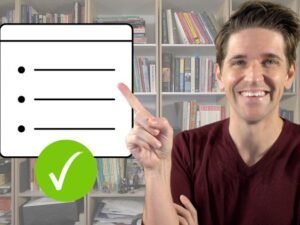- 030 244 2330
- info@preconceptacademy.com
Clear English Pronunciation

- Description
- Curriculum
- FAQ
- Reviews
Thank you for considering enrollment in my Clear English Pronunciation class!
This course is changing the way people speak. I’m Andrea Giordano, your guide for this 25-video course designed to improve your English speaking skills. We’ll accomplish this together as I walk you through each and every possible sound in the English language, focusing on an American accent. Together, we will be able to improve your speaking skills dramatically!
Throughout these 25 videos, you will see amazing improvements in your pronunciation skills. I’m so confident you will love this course, you can email me directly with any questions before your purchase. Simply email me at andrea@studywithandrea.com.
Don’t just take my word for it. Here are a few reviews written by actual students, just like you:
- “I’ve been studying English for years and I’m learning things that no one had ever taught me before.” – Susana V.
- “Excellent course! I like it! Kudos to the teacher.” – Gregory J.B.
- “WOW it’s an amazing experience. I have been struggling with my pronunciation for years. I have improved a lot during a few hours. Thank you for putting this course together for us.” – Mubasher H.
- “Beyond compare! Excellent! Great! Absolutely awesome!!! Great description, easy to follow along, clear pronunciation, highly professional lessons. Thank you!!!” – Stanislov F.
I look forward to having you as a student!
Andrea Giordano
-
1Welcome to Clear English PronunciationVideo lesson
Welcome to Clear English Pronunciation!
I'm Andrea Giordano, your guide for this life-changing course. You've made an amazing decision to join this class. You are going to see an amazing improvement in your pronunciation skills.
First, I want to introduce myself. My name is Andrea Giordano, and I have been teaching English and linguistics at universities in the United States for 14 years. I have a Master's Degree in TESOL, which is Teaching English to Speakers of Other Languages. And I've been blessed to teach thousands of English learners just like you on my websites, podcasts, and youtube channel. I've helped students from every country in the world.
The student I'm most excited about though is YOU! You have an amazing opportunity in front of you to change your life through this course. Speaking English clearly will open up doors of opportunity for you. This course will change how you speak forever.
It's hard work though! To get the most out of this course, be sure to do the following things:
Log on to the class regularly. The more you log in and learn, the better your pronunciation will be.
Practice, practice, practice. I'm going to give you lots of practice exercises and activities. The students who practice the most will grow the most! Watch and re-watch the videos so you can speak more clearly.
Most important: Get started! Start speaking more clearly so you can change your life.
Happy Learning!
Andrea
-
2Your Journey Starts HereVideo lesson
Assignment Instructions
Here’s the Activity:
Open the camera app on your phone.
Press Record
Read these sentences: “A quick brown fox jumps over the lazy dog. I want to catch the fox before he jumps over me!” (Don’t practice. Just pronounce it like you normally would.)
Save the video until the very end of the course. This is so important! You’re going to read this sentence at the end of the course and compare your before/after pronunciation.
Take a minute to record this sentence, and then let’s get started on the first lesson so you can speak English clearly!
-
3Place of ArticulationVideo lesson
In this video, you will learn about the place of articulation, or the location of where sounds are produced.
You will learn:
Where to place your tongue, teeth, and lips when creating sounds
How different sounds involve different parts in the mouth
How to pronounce all of the consonant sounds in English.
The place of articulation is important in pronunciation, because you must know where to produce sounds in order to pronounce them correctly.
Here are a few key places of articulation you will learn in this lesson:
labials - lips
dentals - teeth
tongue
palate - roof of the mouth
alveolar ridge - the gums behind your top teeth
If you are not pronouncing a consonant correctly, it's usually because you are not articulating the consonant in the correct location.
Here is a list of the sounds you will learn today:
Bilabials: /p/ /b/ /m/
Labiodentals: /f/ /v/
Interdentals: /θ/ /ð/
Alveolars: /t/ /d/ /n/ /s/ /z/ /l/ /r/
Palatals: /ʃ/ /ʒ/ /tʃ/ /dʒ/ /j/
Velars: /k/ /g/ /ŋ/
Comment below with the sounds that were most difficult and which sounds were easiest for you.
Great work! You are working toward the amazing goal of speaking more clearly.
-
4Manner of ArticulationVideo lesson
In this video, we will talk about "manner of articulation", or how we make sounds. It's important to know how to make the sounds of English so you can speak more clearly.
When we learn our first (native) language, we don't have to think about how to create a sound. We just naturally say it. However, as second language learners, you will have to think about how to create certain sounds, because it doesn't always come naturally.
There are six different ways, or manners of articulation, that we will discuss in this video:
stop - We build pressure of air and then release it. This is a sudden burst of air. Examples include: /p/ /b/ /t/ /d/ /k/ /g/
fricative - We stop part of the air so it can't come through everywhere. It is a stream of air. /f/ /v/ /s/ /z/ /h/ /ʃ/ /ʒ/ /ð/ /θ/
affricate - We combine stops and fricatives to form affricates. Examples include: /tʃ/ and /dʒ/.
nasal - We close our palate and let air stream through the nose. Examples include: /m/ /n/ /ŋ/
liquid - We let air stream on the sides of our tongue. Examples include: /r/ /l/
glide - We move our mouth constantly from a articulation to a vowel sound. Examples include: /w/ and /j/
-
5Short Vowel SoundsVideo lesson
In today's lesson, we will talk about short vowels. These five vowel sounds are essential in English pronunciation. The sounds that we will focus on are as follows:
/æ/ cat, tap, past, ran
/ɛ/ bet, test, net, Ben
/ɪ/ kick, tip, pin, sit
/ɑ/ top, cot, Don, pop
/ʌ/ cup, nut, pup, bun
There are rules that will help you know whether a vowel is short or long. If you follow these rules, you will know when a vowel is short or long.
Rule #1:
If there is only one vowel in a single syllable or a monosyllabic word, that vowel is short.
Rule #2
If the vowel is followed by two consonants, even if they are followed by another vowel, the first vowel will be short.
Rule #3
If the vowel comes before the letters "ck", the vowel will be short. If a vowel comes before a "k" by itself, it will be a long vowel.
Rule #4
If the vowel comes before a /dʒ/ sound (like in 'judge') or /tʃ/ sound (like in 'catch'), it will usually be a short sound.
When we get to the practice part of the lesson, repeat these words with me:
/æ/
and, ax, wax, can, man, tag, bag, ran, cap, map, jam, and, band, rat, bat, pat, sat, mad, sad, bad, dad
/ɛ/
egg, leg, sled, step, tent, bed, fed, red, nest, rest, vest, web, get, jet, met, set, pet, pen, ten, men, pen, fell, well, sell
/ɪ/
dig, pig, wig, dip, hip, lip, tin, pin, win, did, hid, kid, lid, milk, silk, swim, list, sit, bit, fit, hit, pit, fill, kill, pill, will
/ɑ/
God, nod, sod, hop, mop, top, pop, plop, dot, got, cot, stop, jot, not, fox, ox, box, mom, mob, rob, sob
/ʌ/
cub, tub, rub, bud, mud, run, sun, cup, pup, buzz, but, putt, nut, bug, dug, hug, mug, tug, cut, gum, jump, pump, dump
-
6Long Vowel SoundsVideo lesson
In today's lesson, we will talk about long vowels. These five vowel sounds are essential in English pronunciation. The sounds that we will focus on are as follows:
A /eɪ/ say, babe, paid, weight
E /i/ see, need, pea, sing
I /aɪ/ eye, ride, bright
O /oʊ/ row, so, grow, though
U /u/ you, cute, flute, huge
There are rules that will help you know whether a vowel is short or long. If you follow these rules, you will know when a vowel is long.
Rule #1
When a word has two vowels, you usually say the first vowel, and the second vowel is silent.
A - mail, gain
E - hear, near, wheat
I - dial, trial
O - coat, toe
U - fruit, juice
This is not usually true when "I" comes directly before "E". In that case, it sounds like the long "E".
Rule #2
When a vowel and consonant are followed by an ‘e’, the ‘e’ is almost always silent, but it causes the first vowel to be long.
Examples: ate, plane, Pete, like, nine, rope, note, cube, flute.
Rule #3
If a word has one vowel and it comes at the end of the word, that word usually has a long vowel sound.
Examples: he, we, hi, go, no
This is not usually true for an "a" at the end of a word with only one vowel.
Rule #4
'I' or 'O' can be long when they come before two consonants.
Examples: stroll, kind, gold, child
When we get to the practice part of the lesson, repeat these words with me:
A /eɪ/ - mail, gain, bake, ape, paint, gray, nail, main, lay, stay, sail, take, date, pay, fade, wave, way, made
E /i/ - see, seal, hear, beef, wheat, sheep, tea, bee, feel, teen, feet, meal, ear, need, meat, weep, key
I /aɪ/ - hide, bike, dime, lime, vine, wipe, pie, dive, ride, side, chime, cry, dry, wise, pine, sky, child
O /oʊ/ - road, coat, hole, rope, stove, grow, know, show, close, chose, cone, tone, stone, joke, soap
U /u/ - June, true, new, crew, knew, flew, stew, juice, cute, flute, dune, blue, clue, mule, rule, cube
-
7Common Vowels vs. DiphthongsVideo lesson
Common Vowels vs. Diphthongs
Common vowel sounds in General American English include:
/i/ as in eat, meet, living, and busy
/ɪ/ as in it, kit, sick, and pin
/ɛ/ as in end, best, dress, and better
/æ/ as in at, apple, rat, and madder
/u/ as in pool, dune, soup, and jewel
/ʊ/ as in book, should, pudding, and put
/ʌ/ as in but, blood, come, and sun
/ɔ/ as in bought, daughter, long, and boss
/ɑ/ as in opera, father, farm, and heart
Other vowels, called diphthongs, are produced by moving your mouth and tongue while you say them.
Common diphthongs in General American English are as follows:
/eɪ/ as in ate, sleigh, pain, flavor, and say
/oʊ/ as in toe, grow, go, and goat
/aɪ/ as in I, tie, cry, lime, light, and eye
/aʊ/ as in proud, mouse, cow, about, and now
/oɪ/ as in toy, voice, and noise
For extra study, look at the different ways that these diphthongs can be spelled. Notice how these vowel sounds can be spelled in many different ways.
1) The sound /eɪ/ as in SAY
Spelling "A-consonant(s)-E"
rate – fate – base – place – same – name – take – ache – age – wage – save – change
Spelling "AY"
ray – gray – play – lay – day – may – say
Spelling "EY"
hey – prey – they
Spelling "AI"
rain – main – aim – brain – drain – train – stain – mail
Spelling "EIGH"
weight – weigh – eight – vein
Spelling "EA"
break – great – steak;
2) The sound /aɪ/ as in TIE
Spelling "I-consonant(s)-E"
ride – nice – life – smile – wise
Spelling "I"
I - idea - child – wild – climb
Spelling "IGH"
high – sigh – sign – right
Spelling "IE"
lie – die – tie
Spelling "YE"
dye – rye – bye
Spelling "EYE"
eye
Spelling "UY"
buy – guy
Spelling "Y"
dry – fry – try – style
3) The sound /aʊ/ as in NOW
Spelling "OW"
how – cow – now – owl – brown – crown – crowd – powder – browse
Spelling "OU"
loud – proud – cloud – out – mouse – south – couch - found – ground – sound – count
4) The sound /oɪ/ as in BOY
Spelling "OI"
noise – voice – avoid – join – point – boil
Spelling "OY"
joy – toy – boy – loyal – royal – voyage – oyster
5) The sound /oʊ/ as in NO
Spelling "O-consonant(s)-E"
phone - note – notice – lonely – home – hope
Spelling "O"
go – ago – no – toe – hero – veto – echo – motto - bold - most - both
Spelling "O-consonant(s)-vowel"
solar – total – motor – bonus – focus – vogue – social
Spelling "OA"
road – load – boat – coat – goal – coal – coach – roast – toast
Spelling "OU"
soul – though – although – dough
Spelling "OW"
low – know – show – tow – owe – own – bowl – blow
-
8Mastering Vowel SoundsVideo lesson
Common Vowel Sounds in General American English Include:
/i/ as in eat, cheese, free, and busy
/ɪ/ as in it, pin, sick, and lip
/ɛ/ as in end, rest, press, and better
/æ/ as in at, apple, ran, and mad
/u/ as in pool, moon, soup, and do
/ʊ/ as in book, should, foot, and put
/ʌ/ as in but, blood, come, and sun
/ɔ/ as in bought, daughter, long, and boss
/ɑ/ as in opera, pop, farm, and part
/i/ vs. /ɪ/
beat/bit
reach/rich
green/grin
peel/pill
seat/sit
/ɪ/ vs. /ɛ/
sit/set
pin/pen
will/well
litter/letter
bit/bet
/æ/ vs. /ɛ/
and/end
bag/beg
man/men
bat/bet
sand/send
/u/ vs. /ʊ/
food/foot
pool/pull
fool/full
shooed/should
stewed/stood
/ʌ/ vs. /u/
but/boot
hut/hoot
nun/noon
rough/roof
duck/duke
/ɑ/ vs. /æ/
top/tap
pot/pat
hot/hat
cop/cap
rock/rack
/ɔ/ vs. /i/
bought/beat
walk/week
log/league
saw/see
pause/pees
-
9Learning Activity: Ball, Bell, Bill, Bowl, BullVideo lesson
Learning Activity
For this learning activity, we're going to learn that 5 little words can have a big effect on your vowel pronunciation. Practice these 5 words with me as you get faster and faster at pronouncing these sounds clearly.
ball, bell, bill, bowl, bull
This is one of my favorite activities! Did you enjoy it?
-
10SchwaVideo lesson
Do you know what the most common sound in English is?
Think about it for a minute. What sound do people make more than any other? I'll give you a hint: it's a vowel sound. Is it the short "a" sound? No. What about the long "e" sound? Nope, not that one either. It's actually a vowel sound that isn't actually written as its own letter! It's the schwa sound. "The what?" The schwa. It's the most popular sound in English.
"What is a schwa?" you ask. The schwa is the unstressed "uh" sound in English. Some syllables (parts of words) are stressed (louder, higher, clearer) when spoken, and some syllables are unstressed (softer, lower, less clear). Those unstressed syllables usually change into an "uh" or schwa sound.
It is often the sound in grammar words such as articles (a, an, the) and prepositions (in, on, of, about), because those types of words are often unstressed.
Getting the schwa sound right is a good way of making your pronunciation more natural. People who use the schwa sound to sound like native speakers!
-
11Consonants - Voiced and VoicelessVideo lesson
Today we will talk about all 24 consonant sounds in English, and you will learn the difference of when something is voiceless and when it's voiced. Follow along with these lists and make sure you are saying these sounds out loud. Practice, practice, practice!
Voiceless sounds are created when the vocal folds are spread apart in the throat, and air from the lungs passes between them freely.
Voiced sounds are created when the vocal folds in the throat are pulled together, and the air from the lungs repeatedly pushed them apart as it passes through, creating a vibration effect.
One way to check if a sound is voiceless or not is to touch your hand to your throat and see if you feel any vibration in your throat. If there is no vibration, it's voiceless. If there is vibration, it's voiced.
Practice with me as we say these 24 consonant sounds:
Voiceless consonants
/p/ park
/t/ town
/k/ coat
/f/ fan
/s/ sip
/ʃ/sure
/tʃ/ chicken
/θ/ thigh
/h/ hello
Voiced consonants
/b/ bark
/d/ down
/g/ goat
/v/ van
/z/ zip
/ʒ/ treasure
/dʒ/ Jane
/ð/ thy
/m/ mom
/n/ nap
/w/ wide
/l/ love
/r/ red
/j/ yellow
/ŋ/ sing
-
12Mastering the P and B SoundsVideo lesson
P and B
/p/ and /b/ are formed by bringing your two lips together and giving a sudden burst of air. /p/ is voiceless, and /b/ is voiced.
Follow along as we practice these /p/ and /b/ minimal pairs:
Initial Position
pea/bee
pin/bin
peg/beg
pay/bay
park/bark
pig/big
peas/bees
path/bath
pug/bug
poor/bore
Final Position
rope/robe
tap/tab
lip/lib
cop/cob
cup/cub
-
13Mastering the T and D SoundsVideo lesson
T and D Sounds
/t/ and /d/ are formed by bringing your tongue to your alveolar ridge (above your front teeth) and giving a sudden burst of air. /t/ is voiceless, and /d/ is voiced.
Follow along as we practice these /t/ and /d/ minimal pairs:
Initial Position
ten/den
tea/D
tore/door
town/down
tie/die
tip/dip
tart/dart
tan/Dan
tot/dot
tear/dare
Final Position
lit/lid
cot/cod
wrote/road
fat/fad
feet/feed
-
14Mastering the F and V SoundsVideo lesson
F and V Sounds
/f/ and /v/ are formed by bringing your top teeth to the back of your bottom lip and making a stream (continuous flow) of air. /f/ is voiceless, and /v/ is voiced.
Follow along as we practice these /f/ and /v/ minimal pairs:
Initial Position
fee/V
foul/vowel
fan/van
fear/veer
fine/vine
file/vile
fail/veil
fat/vat
feel/veal
fast/vast
Final Position
surf/serve
safe/save
life/live
grief/grieve
belief/believe
-
15Mastering the K and G SoundsVideo lesson
K and G Sounds
/k/ and /g/ are formed by bringing the back of your tongue to the back of your mouth (velum or soft palate) and producing a sudden burst of air. /k/ is voiceless, and /g/ is voiced.
Follow along as we practice these /k/ and /g/ minimal pairs:
Initial Position
coat/goat
cold/gold
cot/got
cap/gap
cage/gauge
card/guard
coal/goal
curl/girl
cut/gut
Cass/gas
Final Position
back/bag
luck/lug
sack/sag
snack/snag
jock/jog
-
16Mastering the CH and J SoundsVideo lesson
/t̬ʃ/ ("CH") and /dʒ/ ("J") Sounds
/t̬ʃ/ ("CH") and /dʒ/ ("J") are formed by bringing the front of your tongue to the alveolar ridge and producing a sudden burst of air. /t̬ʃ/ is voiceless, and /dʒ/ is voiced.
Follow along as we practice these /t̬ʃ/ and /dʒ/ minimal pairs:
Initial Position
cheap/Jeep
chin/gin
choke/joke
chump/jump
chain/Jane
char/jar
cheer/jeer
Chet/jet
choice/Joyce
chest/jest
Final Position
etch/edge
lunch/lunge
rich/ridge
search/surge
H/age
-
17Mastering the S and Z SoundsVideo lesson
S and Z Sounds
/s/ and /z/ are formed by bringing the sides of your tongue to the inside of your teeth and producing a stream of air. Your tongue should lightly touch your bottom front teeth. /s/ is voiceless, and /z/ is voiced.
Follow along as we practice these /s/ and /z/ minimal pairs:
Initial Position
sewn/zone
Sue/zoo
seal/zeal
sit/zit
sip/zip
see/Z
sap/zap
sin/zin
Final Position
loose/lose
device/devise
bus/buzz
race/raise
ice/eyes
face/phase
niece/knees
-
18Mastering the L and R SoundsVideo lesson
L and R Sounds
/l/ and /r/ can be tough sounds for a lot of people! However, you can learn how to pronounce these challenging sounds so that you never say "light" instead of "right" again. They are actually formed very differently.
/l/ is formed by relaxing your lips, and bringing the tip of your tongue to the back of your top teeth, or the bottom of your alveolar ridge. Then when you say the sound, your tongue drops down a little.
/r/ is formed by relaxing your lips, keeping them slightly open. The tip of the tongue curls up towards the roof of your mouth, although it does not touch it. The sides of your tongue should touch the insides of your top teeth.
Follow along as we practice these /l/ and /r/ minimal pairs:
Initial Position
light/right
lead/read
load/road
lock/rock
lane/rain
lip/rip
laid/raid
lap/rap
lows/rose
loot/root
Medial Position
play/pray
blue/bruise
clue/cruise
clown/crown
alive/arrive
-
19Mastering the M and N SoundsVideo lesson
M and N Sounds
/m/ is a nasal sound, formed by bringing the lips together and voicing sound.
/n/ is formed similarly to /d/ and /t/. You bring your tongue to your alveolar ridge (above your front teeth). But it's different from /d/ and /t/ because they have a short burst of air, and /n/ is a nasal sound with no burst of air. You actually do not let air pass through.
Follow along as we practice these /m/ and /n/ minimal pairs:
Initial Position
mow/know
might/knight
mere/near
me/knee
moo/new
moon/noon
meal/kneel
mice/nice
mat/gnat
mitt/knit
Final Position
cam/can
dime/dine
term/turn
some/son
am/an
-
20Mastering the TH SoundsVideo lesson
TH Sounds
In English, there are two TH sounds. One is voiceless /θ/, and one is voiced /ð/.
The voiceless and voiced TH sounds are formed in the same way.
/θ/ and /ð/ are pronounced with your tongue between your teeth or even sticking out of your mouth, and you can make sure you pronounce it clearly by putting your finger vertically in front of your lips and checking that it gets wet when you make this sound.
Examples of the voiceless TH sound /θ/ are the initial position of the words:
thin
thought
and the final sound in words like:
bath
both
Examples of the voiced TH sound /ð/ are:
these
the
and the final sound in words like:
bathe
clothe
Both phonemes are consistently spelled "th".
The TH sound is a tough one for English learners! It's often confused with the sounds like /t/, /d/, /s/, and /f/. Because those are the common mistakes English learners make, we're going to practice minimal pair sets with /t/, /d/, /s/, and /f/. Get ready for lots of practice!
Repeat after me as we practice minimal pairs for both TH sounds (/θ/ and /ð/) against the /t/ sound:
TH/T
Initial Position
thanks/tanks
thorn/torn
thick/tick
then/ten
these/tease
those/toes
than/tan
Final Position
both/boat
bath/bat
path/pat
death/debt
Repeat after me as we practice minimal pairs for the voiced TH sound (/ð/) against the /d/ sound:
TH/D
Initial Position
they/day
thee/D
thy/die
those/dose
their/dare
though/dough
than/Dan
then/den
Repeat after me as we practice minimal pairs for the voiceless TH sound (/θ/) against the /s/ sound:
TH/S
Initial Position
think/sink
thick/sick
thought/sought
thing/sing
thaw/saw
theme/seem
thumb/some
thin/sin
thuds/suds
thump/sump
Final Position
faith/face
fourth/force
tenth/tense
mouth/mouse
math/mass
myth/miss
path/pass
youth/use
worth/worse
growth/gross
Repeat after me as we practice minimal pairs for the voiceless TH sound (/θ/) against the /f/ sound:
TH/F
Initial Position
thin/fin
thought/fought
think/fink
thirst/first
three/free
throws/froze
threat/fret
Final Position
death/deaf
oath/oaf
TH sounds can be really tricky! However, with enough practice, you can pronounce TH sounds like a native!
-
21Mastering the SH SoundVideo lesson
The SH sound /ʃ/
When you say the “Sh” sound, your lips are rounded and your tongue is not going to touch anywhere in particular in your mouth. Your tongue is kind of just floating and should not touch up against your teeth. It is a soft sound as if you were trying to tell someone to be quiet.
One sound that SH is frequently confused with is the CH sound. The CH sound is a quick sound. It's a short burst of air, whereas the SH sound is a long stream of air. Example: ship/chip
The SH /ʃ/ sound is a tough one for English learners! It's often confused with the sounds like /s/, /z/, /θ/ (TH), and /tʃ/ (CH). Because those are the common mistakes English learners make, we're going to practice minimal pair sets with /s/, /z/, /θ/ (TH), and /tʃ/ (CH). Get ready for lots of practice!
SH/S
show/sew
sheet/seat
shower/sour
shell/sell
ship/sip
shack/sack
shine/sign
Shaw/saw
shock/sock
shell/cell
SH/Z
shoe/zoo
shed/zed
she/Z
shack/Zach
ship/zip
SH/TH
sheaf/thief
shorn/thorn
shanks/thanks
she/thee
shy/thy
shay/they
share/their
show/though
SH/CH
shoes/choose
shop/chop
share/chair
sheep/cheap
shoe/chew
ship/chip
-
22Mastering the W and V SoundsVideo lesson
W and V Sounds
To correctly pronounce the /w/ sound, form your lips into a small, tight circle. Imagine whistling or blowing out a candle.
Your jaw should be mostly closed to make the sound, but your teeth should not touch. Then you create a voiced sound from your throat and open the circle wider.
Here is a minimal pair list to practice the /w/ and /v/ sounds.
Initial Position
wow/vow
whale/veil
worse/verse
west/vest
wheeze/V's
wet/vet
whine/vine
Wayne/vein








